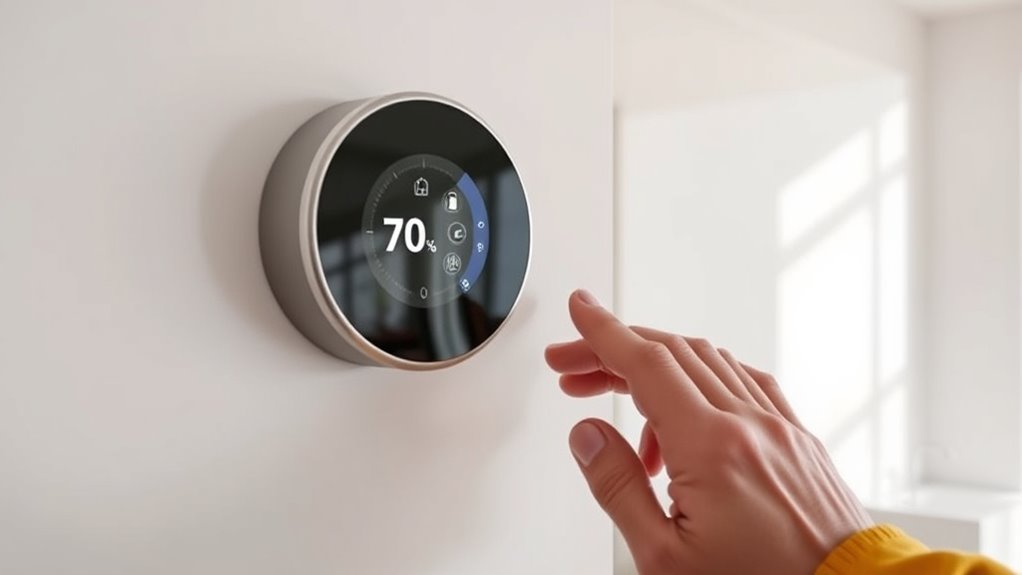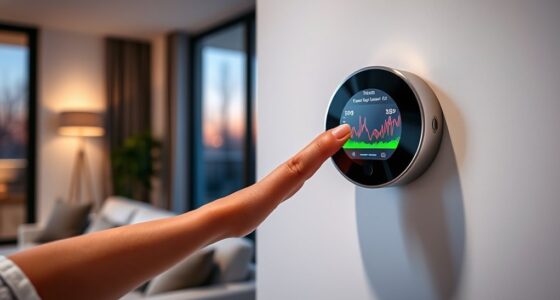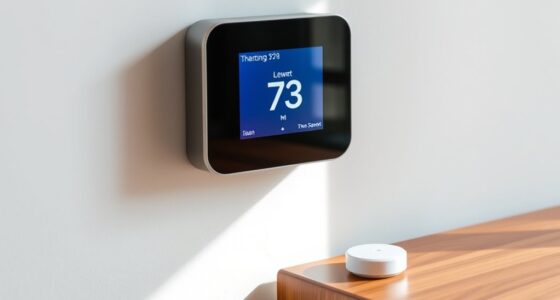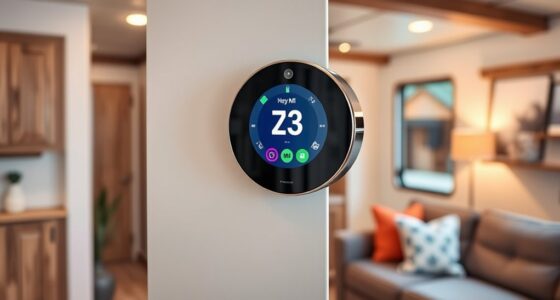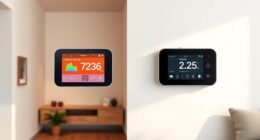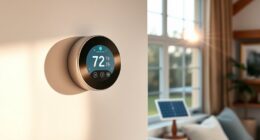When buying a smart thermostat for your new construction home, focus on models compatible with your HVAC system and that offer features like remote control, learning schedules, and energy reports. Consider installation needs, such as whether a C-wire is required, and plan placement for accurate sensing. Look for options with user-friendly interfaces and reliable connectivity. If you’re curious about ideal setup tips and maximizing benefits, there’s more to explore to guarantee you make the best choice.
Key Takeaways
- Ensure compatibility with your HVAC system and confirm if a C-wire or power-sharing solution is needed.
- Select a thermostat with features like remote control, scheduling, and smart learning capabilities.
- Choose an interior wall at eye level, away from drafts, direct sunlight, and heat sources for accurate sensing.
- Consider pre-wiring options during construction to simplify installation and future upgrades.
- Check for Wi-Fi connectivity and integration options with other smart home systems for enhanced automation.
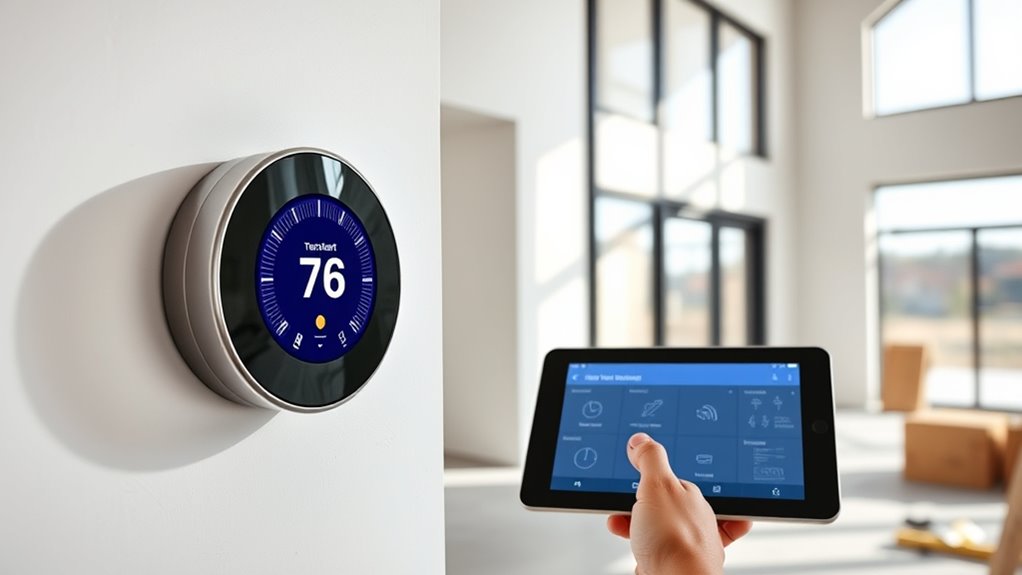
Smart thermostats have become an essential upgrade for anyone looking to save energy and enhance home comfort. When you’re building a new construction home, integrating a smart thermostat from the start can set the stage for efficient climate control and long-term savings. One of the main advantages is improved energy efficiency, as these devices adapt to your schedule and preferences, reducing unnecessary heating or cooling. To maximize these benefits, it’s important to consider some key installation tips that ensure your smart thermostat performs effectively.
First, you should choose a location that accurately reflects your home’s overall temperature, avoiding spots near drafts, direct sunlight, or heat sources like lamps and appliances. Installing the thermostat on an interior wall around eye level is ideal, as it allows the device to better sense the room’s true temperature. When it comes to wiring, it’s essential to verify compatibility with your HVAC system. Many smart thermostats are compatible with common systems, but some may require additional accessories or a C-wire for continuous power. If your home lacks a C-wire, you might need to install one or choose a model that operates on power-sharing technology to prevent issues like frequent charging pauses. Additionally, understanding the contrast ratio of your HVAC components can influence how accurately your thermostat manages indoor climate.
Choose an interior wall at eye level, away from drafts and heat sources, for optimal thermostat placement.
During installation, make sure that your wiring connections are secure and correctly labeled, following the manufacturer’s instructions carefully. Proper wiring not only guarantees reliable operation but also prevents potential damage to your system. Additionally, take advantage of any pre-wiring options during the construction phase, which can make the setup process smoother and less intrusive later on. Some smart thermostats come with detailed setup guides or mobile apps that facilitate installation, so use these resources to confirm proper setup and connectivity.
Once installed, take the time to configure your device correctly. Set your preferred schedules, enable geofencing if available, and connect to your Wi-Fi network for remote access. Many smart thermostats learn your habits over time, so starting with a clear plan helps optimize energy efficiency from day one. Regularly updating the firmware and monitoring your energy reports can also identify further savings opportunities.
Frequently Asked Questions
Can Smart Thermostats Be Integrated With Existing Home Automation Systems?
Yes, smart thermostats can be integrated with your existing home automation system, but you need to check compatibility issues first. Not all thermostats work seamlessly with every system, so you should verify compatibility before purchasing. You might need a hub or specific software updates to guarantee smooth integration. Taking these steps helps you maximize your home automation setup and enjoy centralized control over your climate.
Are There Specific Models Recommended for New Construction Homes?
Did you know new construction homes can save up to 30% on energy costs with the right smart thermostat? For your project, consider models like the Nest Learning Thermostat or Ecobee SmartThermostat, which are highly recommended for new builds. Focus on installation considerations such as Wi-Fi connectivity and compatibility with your HVAC system. These options offer easy setup, energy savings, and seamless integration into your home’s automation system.
What Is the Typical Installation Time for a Smart Thermostat?
You can expect the installation duration for a smart thermostat to take about 30 minutes to an hour, depending on your home’s wiring and system complexity. Typically, a technician is required to guarantee proper setup and integration with your existing HVAC system. They handle the wiring, app setup, and configuration, so you can enjoy the benefits of smart control quickly. Keep in mind, more advanced systems may take slightly longer.
How Does Smart Thermostat Energy Savings Compare to Traditional Thermostats?
Smart thermostats typically offer better energy savings than traditional thermostats by optimizing your home’s energy consumption. They learn your schedule and adjust temperatures accordingly, reducing unnecessary heating or cooling. As a result, you can see significant cost savings on your energy bills over time. You’ll also enjoy more control and convenience, making your home more efficient and eco-friendly while lowering overall energy consumption.
Are There Rebates or Incentives for Installing Smart Thermostats in New Homes?
Picture your new home as a treasure chest, and rebate programs are the sparkling gems inside. You can often find government incentives and rebate programs that make installing smart thermostats more affordable. These incentives are designed to encourage energy-efficient upgrades, helping you save money upfront and long-term. Be sure to check local and federal programs, as they can substantially reduce your installation costs and boost your home’s efficiency.
Conclusion
Choosing smart thermostats for your new construction home means embracing convenience, efficiency, and control. It means saving energy, reducing costs, and enhancing comfort every day. It means investing in technology that adapts to your lifestyle, learns your preferences, and simplifies your life. It means making a smart choice for your home, your budget, and your future. Ultimately, it’s about creating a space that’s efficient, comfortable, and tailored to you—because a smarter home starts with smarter choices.
